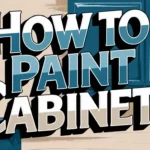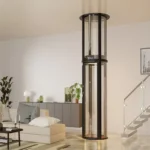If you’ve noticed swollen doors, peeling laminate, or a cabinet hinge hanging loose, don’t panic — you’re not alone. Kitchen cabinets take a daily beating from humidity, heat, and constant use. Over time, even the most well-built cabinetry can start showing signs of wear.
As someone who has spent years restoring kitchens — from quick cabinet hinge repair jobs to full kitchen cabinets repair after water damage — I can tell you that most problems are fixable if you catch them early. This guide walks you through how to repair damaged kitchen cabinet doors, deal with water damage, and keep your cabinets looking new for years to come.
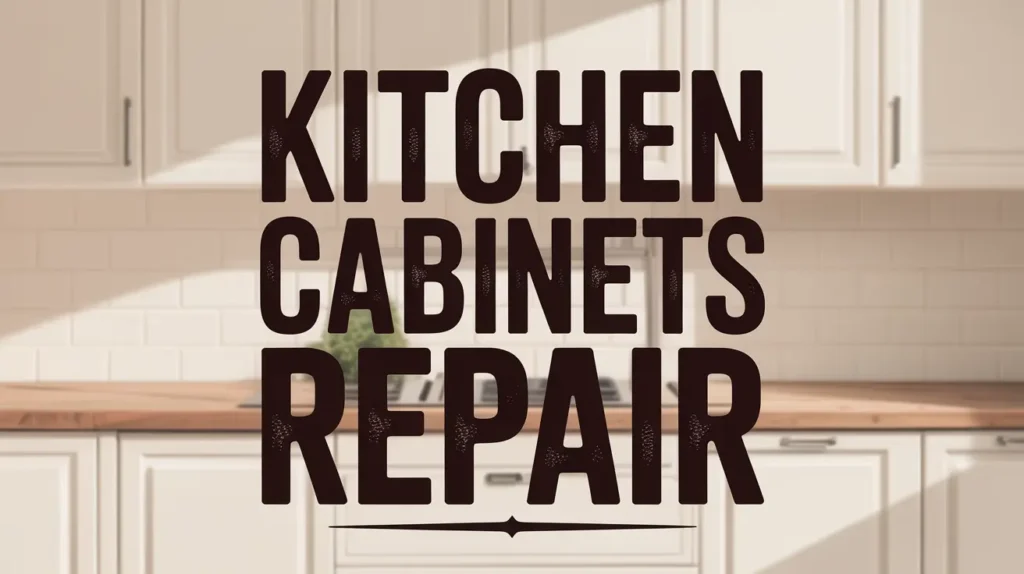
Content
Understanding What Causes Kitchen Cabinets Repair Needs
Before jumping into kitchen cabinets repair, it’s important to understand why your cabinets may be deteriorating. Common culprits include:
- Water exposure: Leaks under the sink or steam from cooking can cause swelling, delamination, or stains.
- Loose hardware: Over time, constant use loosens screws, hinges, and handles.
- Temperature changes: Wood expands and contracts, leading to cracks or misaligned doors.
- Aging finish: Paint or laminate can peel, fade, or chip with frequent cleaning and sunlight.
Knowing what’s causing the issue helps you choose the best repair method — whether it’s DIY work or professional restoration.
Step-by-Step Guide to Kitchen Cabinets Repair
Step 1: Evaluate the Damage
Start by inspecting your cabinets closely. Look for:
- Soft or swollen wood (a sign of moisture damage)
- Loose hinges or doors that don’t align properly
- Peeling laminate or chipped paint
- Musty smells or visible mold under the sink
If the cabinet frame still feels solid, you can likely fix it yourself. If the wood feels spongy or warped, it might need partial replacement or professional restoration.
Step 2: Repair Surface Issues
Fixing Chipped Cabinet Paint or Scratches
Use fine sandpaper to smooth the damaged area, then apply wood filler or touch-up paint that matches your cabinet color. For minor chips, a furniture marker works wonders.
Laminate Cabinet Repair
If the laminate is peeling at the edges, apply a small amount of contact cement, press firmly, and clamp until it sets. For larger areas, replacing the laminate sheet may be the best way to fix water-damaged kitchen cabinets without a full remodel.
Cabinet Hinge Repair
Tighten all screws using a manual screwdriver — not a drill — to prevent stripping. If the holes are worn out, insert wooden toothpicks or dowels dipped in glue, let them dry, and re-screw. This simple trick can extend the life of your cabinet doors significantly.
Step 3: Address Structural and Water Damage
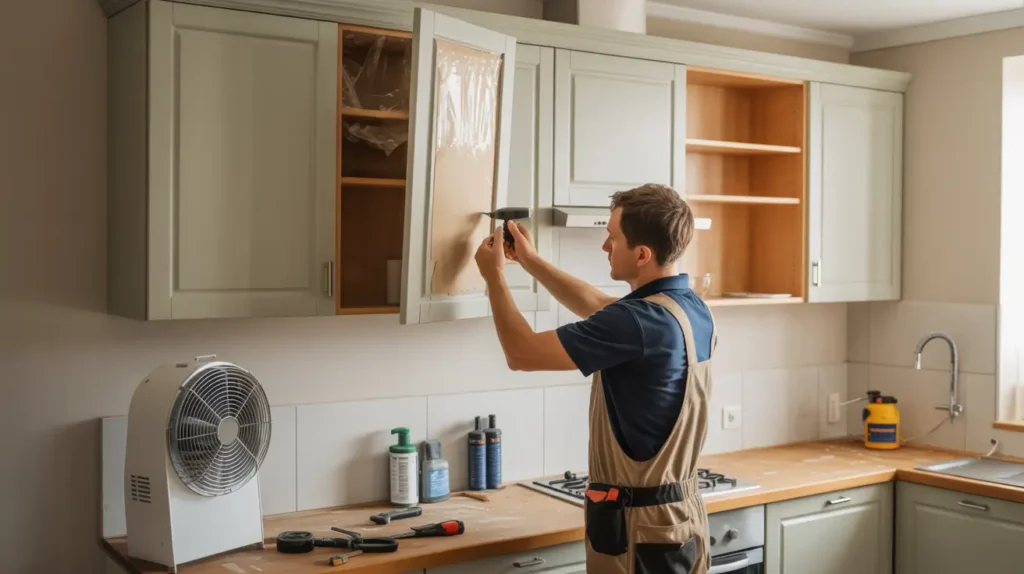
If your cabinet bases or doors have absorbed water, remove the affected pieces immediately and let them dry completely. Use a fan or dehumidifier to speed up the process.
When swelling remains, you can sand down the warped areas and repaint. In more severe cases — especially with MDF (medium-density fiberboard) — replacement is often the only option. MDF tends to crumble when exposed to moisture, whereas plywood can sometimes be salvaged.
Pro Tip: To check if repair is possible, tap the wood. A solid sound means it’s dry and repairable; a dull, soft sound means the material is too damaged.
Step 4: Refinish for a Fresh Look
Once structural repairs are complete, sanding and repainting can make your cabinets look brand new. Choose high-quality enamel or cabinet paint for durability.
If you prefer a natural wood look, apply a stain followed by a protective polyurethane coat — a simple wooden cabinet maintenance step that adds shine and protection against moisture.
Case Study: Water-Damaged Cabinets Under the Sink
A few months ago, a client called me in for a kitchen cabinets repair job after discovering a slow leak under her sink. The cabinet floor had swollen, and the doors wouldn’t close properly. She feared she’d need to replace the entire unit.
Here’s what we did:
- Inspection: We removed the baseboard and confirmed the leak had been fixed. The damage was limited to the bottom panel and one door.
- Drying: We used a fan and dehumidifier for 48 hours to remove all moisture.
- Panel Replacement: The bottom MDF board was beyond saving, so we replaced it with a plywood base, which resists water better.
- Refinishing: We sanded and repainted the doors, then resealed the joints with waterproof caulk.
Total repair time: two days, and the cabinets looked brand new — at a fraction of the cost of full replacement.
This case shows that even serious water damage doesn’t always mean starting over. With prompt action and proper materials, how to repair damaged kitchen cabinet doors becomes manageable — and satisfying.
Preventing Future Cabinet Damage
After years in the field, I’ve learned that the best repair is prevention. Here’s how to protect your kitchen cabinets long-term:
- Seal seams and edges: Use waterproof caulk where cabinets meet walls or countertops.
- Ventilate: Always use an exhaust fan while cooking to reduce humidity.
- Check for leaks regularly: Especially under sinks and dishwashers.
- Use gentle cleaners: Harsh chemicals strip away finishes and cause discoloration.
- Apply protective coatings: A coat of clear varnish or laminate film prevents moisture from seeping into wood.
Implementing these habits ensures your cabinets last longer — saving time, effort, and money in the long run.
When to Call a Professional
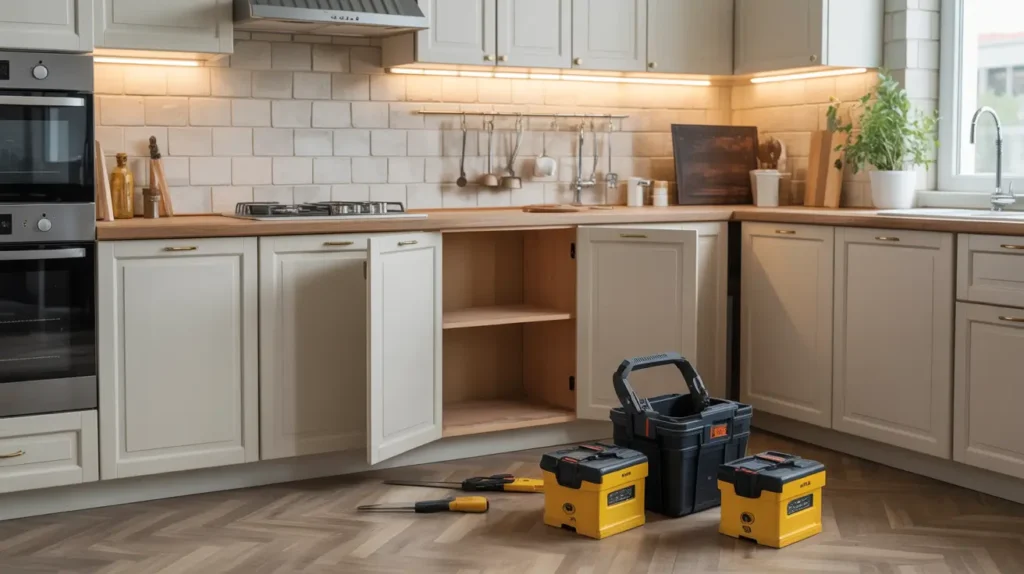
If you’ve tried these tips but your cabinets remain soft, sagging, or moldy, it’s time to call a professional kitchen cabinets repair service. Experts can replace damaged parts, restore structure, and match finishes seamlessly.
Remember, DIY kitchen cabinet repair for beginners is great for minor issues, but serious water damage, warped frames, or mold growth require professional-grade tools and experience.
Final Thoughts
Restoring your kitchen cabinets repair projects doesn’t have to be overwhelming. With the right tools, patience, and a little know-how, you can fix most issues yourself and bring back the beauty of your kitchen. Whether you’re working on Sage Green Kitchen Cabinets, tackling a laminate cabinet repair, tightening loose hinges, or addressing water damage under the sink, consistent maintenance makes all the difference. Your cabinets tell the story of your kitchen — keep them looking their best with regular care and timely repairs.
FAQ’s:
Can damaged kitchen cabinets be repaired?
Yes, most kitchen cabinets repair is possible with sanding, repainting, or replacing damaged panels.
How are kitchen cupboards fixed together?
Kitchen cupboards are joined using screws, brackets, or dowels for strong, long-lasting cabinet frames.
How much to repair a kitchen cabinet?
The cost of kitchen cabinets repair varies, usually between $100–$500 depending on damage and materials.
How to fix cracks in kitchen cabinets?
Fill cracks with wood filler, sand smooth, and repaint — a quick DIY kitchen cabinet repair for beginners.

Amber is a home blogger who loves to share her experiences with others. She likes being motivated and encourages people to be the best they can be.

